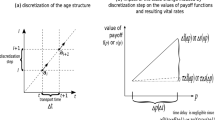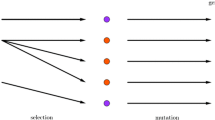Summary
The dynamics of populations of self-replicating, hierarchically structured individuals, exposedto accidents which destroy their sub-units, is analyzed mathematically, specifically with regardto the roles of redundancy and sexual repair. The following points emerge from this analysis:0
-
1.
A population of individuals with redundant sub-structure has no intrinsic steady-statepoint; it tends to either zero or infinity depending on a critical accident rate α c .
-
2.
Increased redundancy renders populations less accident prone initially, but populationdecline is steeper if a is greater than a fixed value α d .
-
3.
Periodic, sexual repair at system-specific intervals prevents continuous decline and stabilizesthe population insofar as it will now oscillate between two fixed population levels.
-
4.
The stabilizing sexual interval increases with increased complexity provided this is accom-panied by appropriate levels of redundancy.
-
5.
The model closely simulates the dynamics of heterosis effects.
-
6.
Repair fitness is a population fitness: the chance of an individual being repaired is a functionof the statistical make-up of the population as a whole at that particular period. Populationsliving at α > α c either engage in sexual repair at the appropriate time or they die out.
-
7.
The mathematical properties of the model illustrate mechanisms which possibly played arole in the evolution of a mortal soma in relation to sexual reproduction.
Similar content being viewed by others
References
Feller, W. (1957). An introduction to probability theory and its applications. Vol. 1. - New York, John Wiley, 509 pp.
Fraccaro, M., U. Laudani, A. Marchi & L. Tiepolo (1976). Karyotype, DNA replication and origin of sex chromosomes in Anopheles atroparvus. - Chromosoma 55, p. 27–36.
Hadorn, E. (1955). Letalfaktoren. - Stuttgart, Georg Thieme, 338 pp.
Howell, S. H. & H. Stern (1971). The appearance of DNA breakage and repair activities in the synchronous meiotic cycle of Lilium. - J. mol. Biol. 55, p. 357–378.
Nanney, D. L. (1968). Ciliate genetics: patterns and programs of gene action. - Ann. Rev. Genet. 2, p. 121–140.
Southern, E. (1974). Eukaryotic DNA. - MTP Int. Rev. of Science, Biochemistry series 1, vol. 6, p. 102–136. - London, Butterworth; Baltimore, University Park Press.
Walker, I. & R. M. Williams (1976). The evolution of the cooperative group. - Acta biotheor. 25, p. 1–43.
Walker, I. (1978). The evolution of sexual reproduction as a repair mechanism. Part I, A model for self-repair and its biological implications. - Acta biotheor. 27, 3/4, p. 133–158.
Williams, G. C. (1975). Sex and Evolution. - Princeton, New Jersey, Princeton University Press, 201 pp.
Author information
Authors and Affiliations
Rights and permissions
About this article
Cite this article
Williams, R.M., Walker, I. The evolution of sexual reproduction as a repair mechanism part II. Mathematical treatment of the wheel model and its significance for real systems. Acta Biotheor 27, 159–184 (1978). https://doi.org/10.1007/BF00115832
Issue Date:
DOI: https://doi.org/10.1007/BF00115832




